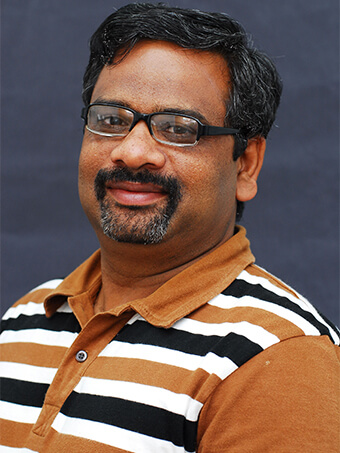
Email: phyrm@nus.edu.sg
Office: S12-02-04
Tel: +65 6516 2616
Current Research
- Spintronics with oxides and magnetic metals
- Spin-charge interconversion
- Multiferroics, Thermoelectrics
- Spincaloric, magnetocaloric and magnetostrictive materials
- Electrical detection of magnetic resonance
- Materials for non-volatile memories
- 2D magnetic materials
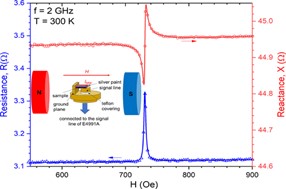
Electrical detection of spin resonance in a paramagnetic organic sample (DPPH) using a new technique developed in the lab.
Research focus: We synthesize various oxide systems and investigate their physical properties to learn about the interplay between charge transport, magnetism, thermoelectricity, magnetoelectricity and magnetoelasticity. We study electrical and magnetic properties from 400 K down to 2 K under a magnetic field up to 7 Tesla. We characterize prepared samples using a number of experimental techniques that are developed in-house which include broadband ferromagnetic resonance, magnetostriction, magnetoimpedance, electrical detection methods for paramagnetic and ferromagnetic resonance, transverse magnetic susceptibility, thermoelectric power, anomalous Hall and Nernst effects, photo Seebeck effect etc.
Currently, we focus on microwave magnetotransport, spin-charge conversion using spin pumping and inverse spin Hall effect, interrelation between anomalous Nernst thermopower and anomalous Hall effect, materials for resistive memories, developing new techniques for electrical and magnetic characterizations.
Representative work:
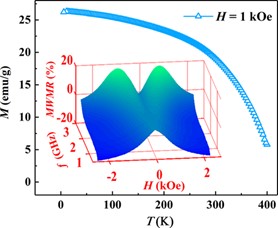
Microwave magnetoresistance: Sr2FeMoO6 is a ferrimagnetic double perovskite known half metallicity and tunnelling dc magnetoresistance between grains. Our investigation showed that magnetoresistance in microwave frequency can be larger than dc magnetoresistance in kOe field range.
Temperature dependence of magnetization in Sr2FeMoO6
Inset: Microwave magnetoresistance (MWMR) as a function of frequency and magnetic field (see R. Das et al., ACS. Appl. Electronic Mater. 3, 3072 (2021))
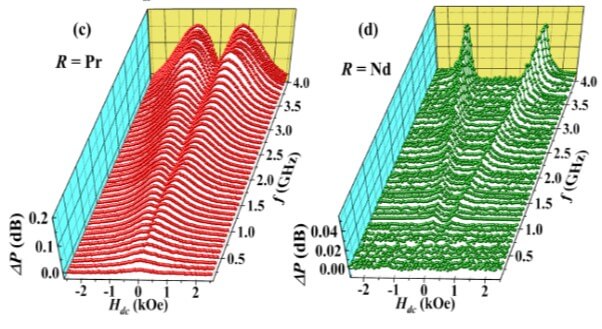
Field modulated microwave absorption: Using a simple “copper strip” coil, we had shown microwave absorption in ferrromagnetic Pr0.6Sr0.4MnO3 (c) and paramagnetic Nd0.6Sr0.4MnO3 (d) can be modulated by external magnetic field at room temperature. We suggest the observed double peak feature to ferromagnetic resonance and paramagnetic resonance in the former and later samples, respectively. (see, A. Chanda and R. Mahendiran, J. Phys. D: Appl. Phys. 53, 215004 (2020)).
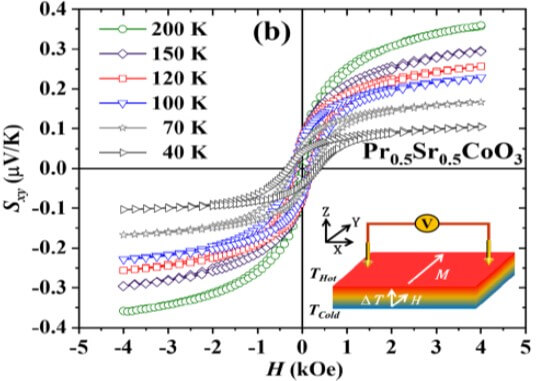
Anomalous Nernst effect (ANE) in Pr0.5Sr0.5CoO3: Nernst effect is the thermal analogue of Hall effect: In the presence of thermal gradient , a voltage is induced in a direction transvers to magnetization (dc magnetic field) and magnetization. ANE exhibits hysteresis as like magnetization. ANE based thermocouples can be used to convert heat to electricity even from non-flat surface unlike a normal thermoelectric device. (See, A. Ghosh et al. AIP Advances, 11, 035301 (2021)).
Selected Publications
- A. Ghosh, A. Chanda, M. Manikandan, and R. Mahendiran, “Rare earth size dependence of anomalous Nernst effect in R0.6Sr0.4CoO3 (R= La, Pr, and Nd)” J. Magnetism and Magnetic Materials, 537, 168240 (2021).
- Y. H. Lee, U. Chaudhuri, and R. Mahendiran, “Electrically detected paramagnetic resonance in Ag-paint coated DPPH ” J. Physical Chemistry C, 125, 18438 (2021).
- R. Das, U. Chaudhuri and R. Mahendiran, “Microwave magnetoresistance and microwave absorption in Sr2FeMoO6”, ACS Applied Electronics Materials, 3, 3072 (2021).
- U. Chaudhuri and R. Mahendiran, “High-frequency magnetotransport in La1-xSrxMnO3 (x = 0.12 to 0.20)”, AIP Advances, 11, 015026 (2021)
- A. Chanda and R. Mahendiran, “Current-driven spin precession in Nd0.6Sr0.4MnO3”, J. Physical Chemistry C, 124, 18226 (2020).
- A. Chanda and R. Mahendiran, “Sharp steps in magnetization, magnetoresistance and magnetostriction in Pr0.6Sr0.4Co1-xGaxO3 (x = 0 to 0.3)”, Applied Physics Letter, 117, 03242 (2020).
- R. Medwal, U. Chaudhuri, J.V. Vas, A. Deka, S. Gupta, M. Duchamp, H. Asada, Y. Fukama, R. Mahendiran and R. Rawat, “Magnetoimpedance of epitaxial Y3Fe5O12 (001) thin film in low-frequency regime”, ACS Applied Materials and Interfaces, 12,41802 (2020).
- K. Rubi and R. Mahendiran, “Large thermoelectric response of B-site diluted ferroelectrics: Ba0.7Eu0.3Ti1-xNbxO3 (x = 0 to 1), J. Solid State Chemistry 281, 12150 (2020)
